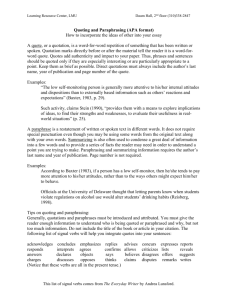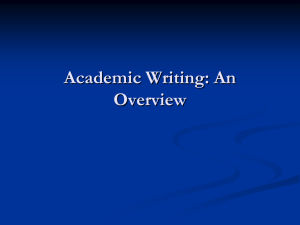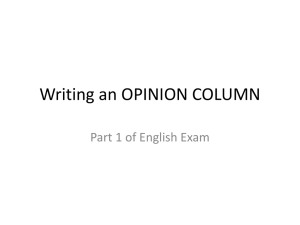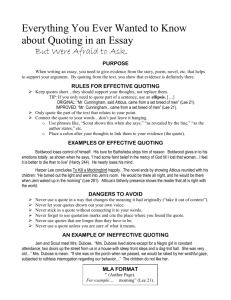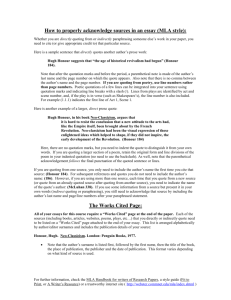paraphrasing & quoting
advertisement
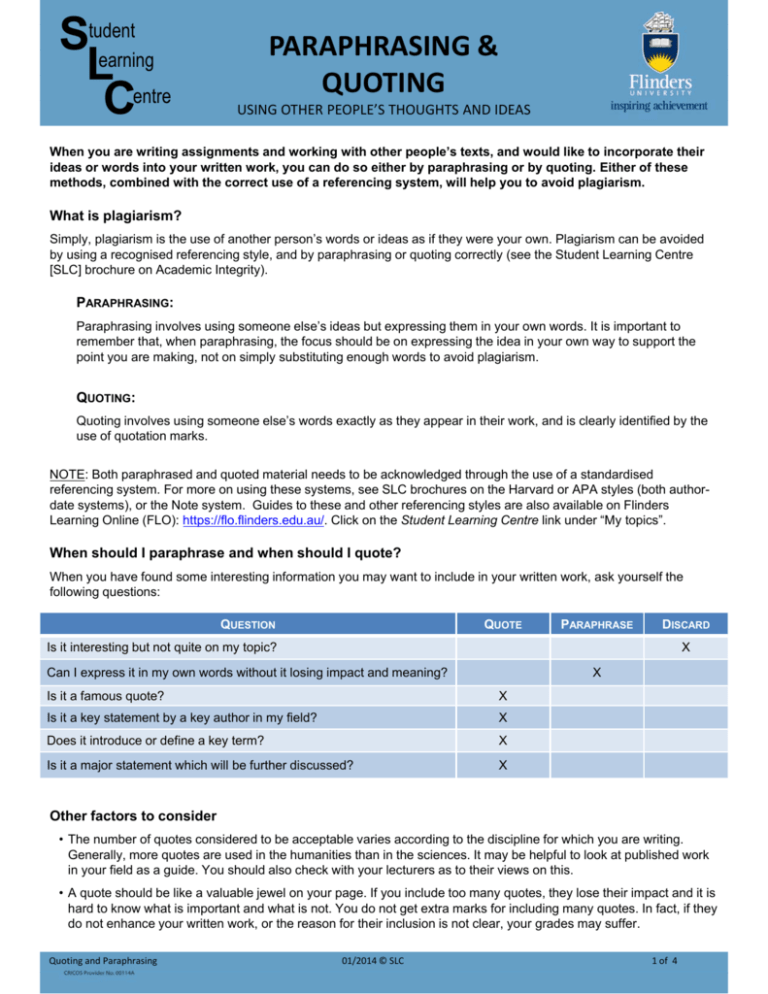
Student Learning Centre PARAPHRASING & QUOTING USING OTHER PEOPLE’S THOUGHTS AND IDEAS When you are writing assignments and working with other people’s texts, and would like to incorporate their ideas or words into your written work, you can do so either by paraphrasing or by quoting. Either of these methods, combined with the correct use of a referencing system, will help you to avoid plagiarism. What is plagiarism? Simply, plagiarism is the use of another person’s words or ideas as if they were your own. Plagiarism can be avoided by using a recognised referencing style, and by paraphrasing or quoting correctly (see the Student Learning Centre [SLC] brochure on Academic Integrity). PARAPHRASING: Paraphrasing involves using someone else’s ideas but expressing them in your own words. It is important to remember that, when paraphrasing, the focus should be on expressing the idea in your own way to support the point you are making, not on simply substituting enough words to avoid plagiarism. QUOTING: Quoting involves using someone else’s words exactly as they appear in their work, and is clearly identified by the use of quotation marks. NOTE: Both paraphrased and quoted material needs to be acknowledged through the use of a standardised referencing system. For more on using these systems, see SLC brochures on the Harvard or APA styles (both authordate systems), or the Note system. Guides to these and other referencing styles are also available on Flinders Learning Online (FLO): https://flo.flinders.edu.au/. Click on the Student Learning Centre link under “My topics”. When should I paraphrase and when should I quote? When you have found some interesting information you may want to include in your written work, ask yourself the following questions: QUESTION QUOTE PARAPHRASE DISCARD Is it interesting but not quite on my topic? X Can I express it in my own words without it losing impact and meaning? X Is it a famous quote? X Is it a key statement by a key author in my field? X Does it introduce or define a key term? X Is it a major statement which will be further discussed? X Other factors to consider • The number of quotes considered to be acceptable varies according to the discipline for which you are writing. Generally, more quotes are used in the humanities than in the sciences. It may be helpful to look at published work in your field as a guide. You should also check with your lecturers as to their views on this. • A quote should be like a valuable jewel on your page. If you include too many quotes, they lose their impact and it is hard to know what is important and what is not. You do not get extra marks for including many quotes. In fact, if they do not enhance your written work, or the reason for their inclusion is not clear, your grades may suffer. Quoting and Paraphrasing 01/2014 © SLC 1 of 4 What you need to know about paraphrasing • The sources of paraphrased ideas need to be acknowledged using the appropriate referencing system and style. • A common question students ask is, ‘How much do I need to change the original wording for it to be considered “acceptable paraphrasing”?’. This in some ways indicates that the student is focussing on a section of text, rather than on the idea. • Some easy ways to identify when this has occurred in a text are when: − the style of writing suddenly changes − there are easily recognisable words or phrases that your lecturer has read in many assignments. When these are put into a Google search or similar, the original sources come up immediately. • Until you fully understand the idea that you are interested in using, you are not ready to attempt to incorporate it into your work. If you understand it, then you should be better able to express it in your own way. • If English is not your first language, then you may have more difficulty in paraphrasing, as your vocabulary and your ability to construct sentences in a variety of ways may be more limited than in native speakers. It sometimes helps to tell someone about the idea first (or even just say it aloud to yourself) before writing it down. If you cannot, you are not yet ready to write about it. Write it down in the words you used to talk about the idea, and then work on improving your expression to make it sound more academic. • Even competent, native speakers of English may have several attempts before they ‘get it right’ when trying to paraphrase an idea and make it ‘fit’ in their written work. Be prepared to have a few attempts at it – it is all part of the drafting process of producing good writing. What is considered to be acceptable paraphrasing and what is considered to be plagiarism? Below is an example of a) an original extract from a paper, b) an acceptable paraphrase, and c) an attempt at paraphrasing which would be considered plagiarism, as it is too similar in wording and structure to the original, and easily recognisable. Examples: A) An original extract ‘The current set of federal government priorities for research appear not to embrace educational issues to any clear degree. In many respects it seems that educational research has drawn the short straw in the research game as currently orchestrated. And yet educational research has never been more important, more relevant to the sort of reform and redevelopment that a knowledge-based society would seek’ (Gill 2004, p. 9). B) An acceptable paraphrase of the above Gill (2004, p. 9) believes that the government’s prioritising of other fields of research over educational research is misguided, given the types of reforms needed in a knowledge-based society such as Australia. Note that the focus is on the point being made, not on the wording, although much of this has been changed. C) A plagiarised version The present Australian government research emphasis does not include educational issues. It appears that educational research has been disadvantaged in the current changes. Gill (2004, p. 9) believes that educational research has never been of more importance, or relevance to the changes sought in a knowledge-based society. Source: Gill, J 2004, ‘Having our work cut out! Reflections on the Australian Association for Research in Education and the current state of Australian educational research’, The Australian Educational Researcher, vol. 31, no. 1, April, viewed 31 August 2006, http://www.aare.edu.au/aer/contents.htm, Quoting and paraphrasing 01/2014 © SLC 2 of 4 QUOTING It is important that when quoting, the section of text that is copied is exactly as it appears in the original. If there has been an error (e.g. a typing error) in the original, you must reproduce it exactly as it appears in the original. You can, however, indicate that the error is not yours by adding [sic] immediately after the error, and then you will not be held responsible for it. ‘It is there [sic] opinion that…’ Single quotation marks are most commonly used to identify quotes, and double quotation marks indicate a quote or an important term within a quote. Eveline (2004, p. 174) pointed out that ‘people who spoke out about a problem that nobody else was noticing were liable to be labelled as “the problem” if their work colleagues and supervisors were not sensitive to the issues. Gender was a classic example of this’. Source: Eveline, J 2004, Ivory basement leadership, University of Western Australia Press, Perth. What you need to know about quoting Quotes need to fit in with the point you are making. See below for examples of how to introduce a short quote and a long quote. Both need to be introduced to the reader by providing the author’s name and a reporting verb. Reporting verbs, such as argues, states, points out, highlights, neglects, omits, maintains and so on, indicate to your reader how you feel about the person’s idea and should be selected carefully. Varying them makes your writing more interesting. Johnson argues that ‘...’ (2007, p. 478). As Mahmoud (2006, p. 45) points out, ‘...’. Harrison ignores ‘ X’ when she says ‘…’ (2006, p. 68). (neutral) (agreement) (critical) Formatting Quotes • Short quotes (of less than approximately 30 words or 3 lines) Short quotes can be integrated into your sentences. Quotation marks must be placed accurately to indicate exactly where a quote begins and ends. Referencing details must be included, either in brackets or by using a numbered note system, according to the referencing style you are using (see SLC brochures on the Harvard, APA and Note systems). As Eveline says, 'the merit of a university employee, student or written product is viewed as being assessed on objective, rational criteria’ (2004, p. 102). Source: Eveline, J 2004, Ivory basement leadership, University of Western Australia Press, Perth. • Long quotes (of more than about 30 words or 3 lines) Long quotes are separated from the rest of the text by an extra line space. The left side (and often the right side also) is indented. Quotation marks are not required because the spacing indicates that it is a quote. Often the font size is reduced to further demarcate it (refer to the relevant referencing style guide). Bold or italic font may also be used in some publications but this is not normally required. Quoting & paraphrasing 01/2014 © SLC 3 of 4 Long quotes are introduced with your own words and a colon (:). For Green and Reid (2008, p. 20), to understand the identity of ‘the teacher’ from a poststructuralist standpoint means understanding the formation of the teacher: as moving into and taking up a distinctive subject-position, or rather, an array of subject-positionings, a professional identity-in-motion. … Becoming and being a teacher in such a view is to be understood as an institutionalised but still always precarious and temporary ‘fixing’ of the interplay between professional identity and social subjectivity. Source: Green, B., & Reid, J.-A. (2008). Method(s) in our madness? Poststructuralism, pedagogy and teacher education. In A. Phelan & J. Sumsion (Eds.), Critical readings in teacher education: Provoking absences (pp. 17-32). Rotterdam, Tapai: Sense Publishers. • You do not have to use a whole sentence or paragraph from the original work. Select the section of relevance to your work and manipulate it, if necessary, by the following methods: • Ellipsis (…) indicates that part of the quote has been omitted. • Square brackets ( [ ] ) indicate that you have added something to make the quote make more sense to the reader. Johnson (as cited in Hendricks & Quinn, 2000, p. 49) claims that ‘The purpose of a case study is to describe the case in its context…[including] aspects of the environment that pertain to that case and shed light on the research question’. Source: Hendricks, M & Quinn, L 2000, ‘Teaching referencing as an introduction to epistemological empowerment’, Teaching in Higher Education, vol. 5, no. 4, pp. 49-55. • Remember to maintain correct grammar when integrating quotes into your work. Academic Integrity at Flinders website and quiz For further examples, Flinders University has an Academic Integrity website and quiz with which you can test your understanding of quoting, paraphrasing, and academic integrity in general. This is available to all students on FLO. Other related sources available at the Student Learning Centre include study guides or online materials on: Academic Integrity, The Harvard Referencing System, The APA Referencing System, The Note Referencing System. Another useful resource is available online at Purdue University Online Writing Lab, on: http://owl.english.purdue.edu/owl/resource/563/1/. STUDENT LEARNING CENTRE REGISTRY BUILDING ANNEXE TEL: 61‐8‐8201 2518 E‐MAIL: slc@flinders.edu.au INTERNET: http://www.flinders.edu.au/SLC POSTAL: PO BOX 2100, ADELAIDE, SA 5001 Quoting and Paraphrasing 01/2014 © SLC 4 of 4
